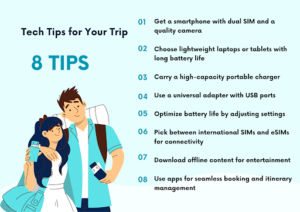TECHNOLOGY
A Guide to Traveling with Technology

Technology is more than just a luxury, it’s a travel necessity. Imagine navigating a foreign city without a map app or booking last-minute accommodations without a smartphone. How do you ensure your tech enhances rather than hinders your journey? This blog will show you how to harness the full potential of your devices while traveling, helping you stay connected, entertained, and safe wherever you go.
Whether you’re a seasoned globetrotter or planning your first adventure, read on to discover how technology can make your travels smoother and more enjoyable.
Choosing the Right Devices for Your Trip
Traveling efficiently also means staying connected and making the most out of your time away. The right devices can dramatically improve a journey, whether it be for getting from one place to another, working, or entertaining oneself.
Smartphones: Smartphones have rapidly become an absolute prerequisite for travel, as they serve to navigate, take photos to send back to family and friends, and remain in contact with loved ones. When selecting a smartphone, consider features like dual SIM capability, long battery life, and a good camera. These features will make sure that you stay connected and have all you need.
Laptops and Tablets: They are lightweight and just perfect for productivity or entertainment. They find a great balance between portability and functionality, which is great for keeping you working or passing time during long journeys. Go for long-life battery types with enough storage to accommodate your needs on travel.
Wearable Technology: Wearables come in the form of smartwatches and fitness trackers, which are fairly popular. Features available include navigation, health tracking, and contactless payments, among many more. They make things easier for you, and safer, so your travel is smoother and more pleasant.

Staying Connected: Internet and Data Solutions
When traveling with technology, staying connected is essential for navigating new places, keeping in touch with loved ones, and ensuring your devices remain functional. To maintain connectivity, consider global roaming plans offered by your carrier, which can provide data, calls, and texts abroad, or purchase a local SIM card upon arrival for potentially better rates.
Traditional SIM cards are widely available and can offer good local rates. However, eSIMs provide the convenience of switching networks without needing a physical card. This can be particularly useful for travelers heading to different countries like Japan, South Korea, Australia, or Spain. Consider you’re heading to Japan. For a seamless experience, consider the best esim for japan to maintain a strong connection during your visit.
Portable Wi-Fi Hotspots: These devices offer reliable internet access and can connect multiple devices. Look for models with long battery life and global coverage to stay connected wherever you go.
Public Wi-Fi Safety: Public Wi-Fi is handy but can be risky. Protect your personal information by using a VPN and avoid sensitive transactions over these networks.
Essential Travel Apps You Must Have
Once you’ve selected the right devices, the next step is to equip them with the right tools. Here are some essential apps every traveler should have:
Navigation and Maps: Google Maps allows you to find your way and create routes without connecting to data. This makes moving within the city or neighborhood you have never seen much easier.
Language Translation: Google Translate allows people to understand others and make their points across with real-time translations and offline capabilities, making the barrier of language less of an issue.
Expense Tracking: Take control of your spending through the development of mobile expense-tracking applications and currency converters.
Power Solutions and Battery Management
No matter how many apps you have or how well you stay connected, none of it matters if your devices run out of power. With travelers relying on technology for everything from maps to communication, power management becomes critical. Let’s explore some power solutions to keep your devices running throughout your journey.
Portable power chargers and power banks: Choose high-capacity power banks with lightweight designs while offering fast charging features. This will ensure you are never without power, no matter where your journey takes you.
Universal Adapters: Most countries are different from one another in terms of power sockets. A universal adapter will allow you to plug into nearly every form of socket around the world and normally includes several USB ports for convenience.
Battery Optimization Tips: Make the most of your battery with screen brightness changes, disabling notifications that you don’t need, and closing apps that you’re not using. This easy upkeep will keep your devices running longer in between charges.
Safeguarding Your Technology
Keeping your devices charged is essential, but protecting them is equally important. Whether it’s from cyber threats or physical damage, safeguarding your technology should be a top priority for any traveler. Here’s how to secure your tech:
Digital Protection: Secure your devices with strong passwords; enable two-factor authentication; and continuously update your software to protect against malware and unauthorized access.
Physical Protection: Anti-theft backpacks feature zippers that are hard for others to access, and hard cases protect against theft or physical damage. It’s better not to leave gadgets unattended in crowded areas.
Backups and recovery plans for important data can involve cloud storage in case the device is stolen or lost. In that respect, having a backup will save time and possibly loads of stress when recovering files.
Entertainment On-the-Go
Travel isn’t just about staying connected and productive; it’s also about enjoying the journey. With devices like noise-canceling headphones and portable gaming consoles, you can keep boredom at bay. Make your journeys enjoyable with the right tech for you when it’s time to chill.
Offline content storage: You can download your music, movies, and books in advance. Many services, such as Spotify and Netflix, can be used offline to keep you entertained in places where you do not have an internet connection.
Portable entertainment devices: You can travel with things such as game players or e-book readers. They can come in quite handy during long trips, and they are also easy on your phone’s battery.
How Technology Can Be Put to Good Use in Planning and Booking a Travel
While entertainment is important, the role of technology starts well before you even begin your trip. From booking flights to finding unique local experiences, technology simplifies every aspect of travel planning. Ease your travel planning with the help of the following technological utilities:
Flight and Accommodation Apps: Use apps like Skyscanner or Airbnb to easily book flights and accommodations. These tools come with features such as price alerts, customer reviews, and comparisons that would let you find the best options.
Travel Itinerary Organizers: Stay organized with apps like TripIt; it allows syncing of bookings and real-time updates on how to stay on schedule concerning your travel plans.
Local Experience Platforms: Discover interesting local activities through websites like Airbnb Experiences and Viator. For instance, these services will provide personalized tours to see any destination like a local.
Post-Travel Tech Management
Manage your technology with ease once you’re back home. Make backups of your travel photos and videos, storing them with cloud storage devices like Google Photos and Dropbox. This will keep those special memories safe and easily located.
You can also share all your experiences and reviews on social media platforms or travel blogs. Not only do other travelers appreciate this, but you tend to relive all your experiences and connect with fellow explorers.
Conclusion
Technology can enhance every aspect of your travel experience, from planning and navigation to entertainment and safety, ensuring you have the right tools and knowledge for any adventure, whether for business or leisure.
Embrace these tech tips and embark on your next journey equipped for success and enjoyment. Safe travels!
Frequently Asked Questions (FAQs)
- How can I ensure my devices are safe from theft while traveling?
To protect your devices, use anti-theft backpacks, secure your devices with strong passwords, and enable tracking features like “Find My Device.” Avoid displaying expensive gadgets in public, and keep them in your carry-on luggage when possible.
- What should I do if I lose internet access during my trip?
If you lose internet access, you can rely on offline maps and saved content on your devices. Also, consider using a portable Wi-Fi hotspot with a prepaid data plan as a backup.
- Are there any travel-specific apps that can enhance my experience?
Yes, there are numerous travel apps designed to enhance your experience. Apps like Google Maps for navigation, TripIt for itinerary management, and Google Translate for language translation are essential for any traveler.
TECHNOLOGY
Finding High-Quality Electronic Devices & Tools: Everything You Need to Know

It can be hard to keep updated with the latest technological devices as retailers constantly work to churn out newer and better products every year. From regular devices like smartphones and laptops to tools like GPS systems for your car, having the highest-quality products can put you above the rest when it comes to your business and personal needs. If you are in the market for a new electronic device, follow this guide so that you will end up with the best products available today. That is, until the next big thing emerges.
Identify Your Needs
Figuring out what you want from a product is the first thing you need to do before you start perusing your options. For example, if you need a new computer for work, you have to think about all of the tasks you will perform on it. This will set you up with a list of all of the non-negotiable features to look for. You should also think about how often you will use the product and how well it will integrate into your daily life. Once you have a good understanding of what you need, you can start looking online or go to a brick-and-mortar location to speak with a tech expert about your options.
Browse Top Retailer Websites
A great starting place is to make a list of your top technology retailers. These can be sellers of trusted products that you have used before or brands that you think have a good reputation for selling quality devices. Once you have three or four in mind, you can start browsing their websites to see the latest products they have to offer. These websites should have expert ratings of each product and detailed photos with descriptions to help you make your decision.
Read Customer Reviews
Before purchasing an expensive electronic device, it is important to get opinions from your peers on how well they work. This can be done in many ways. You can search online forums, look up reviews on third-party websites, or read reviews directly from the retailer’s website. If you want to see a lot of reviews of different brands, head to this Romanian product review website, where you can see which high-quality electronic devices rank the highest among real customers. These user reviews can help paint a better picture of each product and give examples of how they are used in real-world scenarios.
Understand Quality Indicators
Quality indicators of a product usually come from brand reputation, materials used, and certifications. For example, if you buy a product from a brand that you have used in the past and have never had issues with, then you know that a new product from the same brand will likely deliver similar results. As for materials used, this is something you may have to look for in person. Go to the nearest tech retailer so that you can hold the product in your hand. While there, you can also ask a tech expert about the materials used to construct it to see if it is made well.

When looking for a new piece of technology to add to your collection, remember that taking a bit of time to read reviews and seeing the product in person will help you make the best decision. Use these tips to walk away with a reliable electronic device that will be a welcome addition to your home or office.
TECHNOLOGY
The Role of Quality in Tank and Storage System Decisions

When it comes to selecting tanks and storage systems, whether for industrial, agricultural, or commercial use, quality is not just a desirable trait; it is a fundamental requirement. The materials used, the manufacturing standards followed, and the system’s durability can significantly influence operational efficiency, safety, and long-term cost-effectiveness. With so many options available in the market, decision-makers must prioritize quality above all else to ensure reliability and performance. This blog post explores six core aspects of how quality plays a pivotal role in tank and storage system decisions, influencing everything from structural integrity to environmental compliance.

Material Selection and Durability
One of the first and most critical aspects of quality in tanks and storage systems is the choice of materials. High-quality tanks are constructed from materials that match the intended contents, whether that’s water, chemicals, fuel, or food products, and are resistant to corrosion, UV degradation, and temperature fluctuations. For example, stainless steel is often favored in chemical and food storage due to its resilience and non-reactive properties. Polyethylene tanks with UV inhibitors are widely used for water storage in outdoor environments. Inferior materials may lower upfront costs but can lead to early degradation, leaks, or contamination, requiring costly replacements or repairs. Ensuring quality through proper material selection means investing in longevity and safety.
Structural Integrity and Engineering Standards
Ensuring the structural integrity of tanks and storage systems is crucial for safe and reliable operation. Quality tanks are designed to withstand environmental stresses, pressure changes, and everyday wear without compromising their function. Engineering standards guide these designs, setting requirements for materials, welds, and construction. For instance, proper installation of tank stands is important to support the weight and maintain the stability of above-ground tanks, preventing deformation or failure. Without adherence to these rigorous standards, tanks may be prone to leaks, cracks, or collapses, leading to costly damages or safety hazards. Following established engineering guidelines ensures that tanks perform effectively over their lifespan.
Safety and Compliance Considerations
Quality manifests in the system’s ability to meet industry safety requirements and environmental regulations. Storage tanks often hold hazardous or sensitive materials that, if leaked or mishandled, could pose severe risks to personnel and ecosystems. High-quality systems incorporate features like secondary containment, pressure relief valves, and anti-corrosion linings that prevent accidents. They come with certifications indicating compliance with OSHA, EPA, or FDA standards, depending on the application. Cutting corners with low-quality tanks jeopardizes safety and can result in heavy fines, legal liabilities, and reputational damage. Compliance is a byproduct of quality and is vital for maintaining trust and accountability.
Maintenance Efficiency and Lifecycle Costs
Another dimension of quality in tank systems is how easily and economically they can be maintained over their operational life. Well-constructed tanks require fewer frequent repairs and are easier to inspect, clean, and service. Features such as smooth interior surfaces, manways for access, and corrosion-resistant coatings contribute to efficient maintenance. While high-quality systems might have a higher initial cost, their reduced maintenance needs and longer service life make them more economical in the long run. Cheaper alternatives often accumulate costs through frequent breakdowns, unplanned downtime, and higher labor requirements. Thus, evaluating lifecycle cost is key to appreciating the full value of quality.
Customizability and System Integration
Quality includes the adaptability of tanks and storage systems to meet specific operational needs. High-quality manufacturers offer customizable options, such as specific fittings, temperature controls, insulation, and monitoring systems, that ensure seamless integration with existing processes. Customization minimizes compatibility issues and enhances system efficiency. In low-quality tanks, such flexibility is often missing or poorly implemented, resulting in retrofitting complications and inefficiencies. Selecting a quality system means you’re choosing a partner who can tailor solutions to your requirements, further supporting productivity and workflow consistency.
Reputation and Vendor Reliability
The source of your tank or storage system plays a huge role in determining its quality. Reputable manufacturers with a history of excellence are more likely to follow strict quality assurance processes, use superior materials, and provide dependable customer support. These vendors are more transparent about their product certifications and are willing to back their products with warranties and technical documentation. Choosing a supplier based solely on price can result in poor after-sales support, limited product documentation, and inadequate warranty coverage. Working with a trusted vendor ensures the quality of the product and the reliability of service, which is invaluable for long-term operations.

Quality is the cornerstone of every effective tank and storage system decision. From material strength and regulatory compliance to lifecycle cost and vendor support, each factor reinforces the idea that cutting corners in quality can have serious consequences. By prioritizing well-built, reliable systems, businesses protect their investments and enhance operational efficiency, safety, and sustainability.
TECHNOLOGY
How to Evaluate Technical Skills When Hiring Web Developers

Hiring a skilled web developer is one of the most important steps when building a strong online presence. Whether you’re launching a new website, improving an existing platform, or creating a custom web app, you need developers who not only understand your vision but also have the technical ability to bring it to life.
While resumes and interviews help, they don’t always reveal the full picture of a candidate’s technical skills. Knowing how to properly evaluate a developer’s capabilities ensures you’re hiring the right person for the job- and not just someone who can talk the talk.
This guide breaks down how to assess technical skills clearly and effectively so you can hire web developers with confidence.
Understand Your Project Requirements First
Before diving into skill evaluations, you need a clear understanding of your project’s technical needs. Are you building a front-end user interface or a full-stack web platform? Will your website require integrations with APIs, databases, or third-party tools?
Write down what you expect the developer to do. This can include:
- Designing web pages using HTML/CSS
- Coding interactivity with JavaScript
- Using frameworks like React or Vue.js
- Managing backend systems with Node.js, PHP, or Python
- Handling databases such as MySQL or MongoDB
- Deploying to cloud platforms like AWS or DigitalOcean
By defining what skills are needed, you’ll be in a better position to measure whether a candidate has what it takes.
Review Their Portfolio and Past Projects
One of the simplest and most effective ways to evaluate technical skills is by reviewing a developer’s past work.
Look for the following in their portfolio:
- Websites or apps that function smoothly
- Clean, user-friendly design
- A variety of features that demonstrate versatility
- Links that work and don’t lead to errors
- Sites optimized for mobile and different browsers
A good portfolio gives insight into the developer’s real-world experience and shows you the quality of their work. Ask for links to live sites or a GitHub repository.
Test for Core Coding Skills
While portfolios are great, they don’t always prove that a developer wrote the code. That’s where technical tests come in.
You can test for specific skills depending on the role, which includes:
- Front-End Developer Tests
- Back-End Developer Tests
- Full-Stack Developer Tests
Use platforms like HackerRank, CodeSignal, or custom in-house tests to evaluate skill levels.
Use Real-World Scenarios
A great way to evaluate technical skill is by giving candidates a task that mimics something they’d do on the job.
Real-world tasks give you a clear idea of how well a candidate can apply their skills in practical situations. They also show how they approach problem-solving, which is just as important as the final result.
Check Their GitHub or Code Repositories
Developers who are active on GitHub often share their code for others to see. This can be a valuable window into their technical style.
You don’t need to be a developer yourself to see whether their code is neat and organized. If you’re unsure, ask a technical advisor to take a look.
Assess Problem-Solving and Debugging Abilities
Technical skills go beyond writing fresh code. A good developer should also be skilled at debugging and fixing errors.
Watch how they handle roadblocks. Do they stay calm? Do they know where to look? Can they explain their thought process? These are key indicators of a strong developer.
Consider Their Comfort With Tools and Frameworks
Most modern development jobs require the use of certain tools. A good web developer should be familiar with:
- Code editors like VS Code or Sublime
- Version control systems like Git
- Frameworks such as React, Angular, or Vue.js
- CSS preprocessors like SASS or LESS
- Project management tools like Trello or Jira
When evaluating candidates, ask them to describe the tools they use daily and how comfortable they are with each. Their answers can give insight into how fast they’ll adapt to your workflows.
Include Soft Skill Evaluation in Technical Interviews
While this article focuses on technical skills, don’t forget that communication, teamwork, and responsibility are just as important.
During the technical interview, observe how well the candidate can:
- Explain their code or choices
- Listen and ask questions
- Accept feedback or suggest improvements
- Work through a coding challenge calmly and confidently
A skilled developer who communicates clearly will be easier to work with in the long run.
Use Hiring Platforms That Pre-Screen Talent
If evaluating technical skills feels overwhelming, you can use trusted platforms that pre-vet developers for you. Sites like FreeUp, Toptal, and Upwork allow you to hire from a pool of tested professionals.
With Freeup pricing, for example, you’re not only getting skilled developers but also transparent rates and flexible hiring options. You can hire for hourly, part-time, or full-time roles based on your budget and needs. The platform pre-screens freelancers, saving you time on the early stages of technical evaluation.
Don’t Skip Reference Checks
Once you’ve found someone who seems technically sound, always check references. Ask past clients or employers:
- What type of work did the developer do
- How well they met deadlines
- Whether they handled technical challenges efficiently
- How they worked within a team or with project managers
Even a quick email or phone call can confirm whether your top pick is as good in practice as it appears on paper.
Be Clear About Your Expectations
Even the best developer may struggle if expectations aren’t clear from the start. Before making a final offer:
- Define the scope of the job
- Share timelines and delivery goals
- Agree on tools and communication methods
- Make sure they’re comfortable with your tech stack
This sets both sides up for a smoother working relationship and fewer misunderstandings.
Keep Your Hiring Process Consistent
Consistency is key when evaluating multiple candidates. Stick to the same tests, interview format, and review process for each applicant. This ensures fairness and helps you make smarter comparisons.
Document your process for future hires so your team always knows how to evaluate technical skills effectively.
Hire With Confidence
Hiring a skilled web developer doesn’t have to be stressful. By focusing on clear project needs, evaluating real-world skills, and using structured assessments, you can identify candidates who truly match your goals.
Use portfolios, live coding tasks, and problem-solving challenges to dig deeper than a resume. And if you’re short on time or unsure where to start, platforms with transparent systems can give you access to pre-vetted professionals quickly.
Interested in learning more? Browse our other blog posts to gain insights into a range of topics.

 Cartoon1 year ago
Cartoon1 year agoUnlocking the Potential of Nekopoi.care: A Comprehensive Guide

 Game1 year ago
Game1 year agoExploring Aopickleballthietke.com: Your Ultimate Pickleball Destination

 BUSINESS1 year ago
BUSINESS1 year agoWhat Companies Are In The Consumer Services Field

 BUSINESS1 year ago
BUSINESS1 year agoUnraveling the Mystery of 405 Howard Street San Francisco charge on Credit Card

 HOME IMPROVEMENT1 year ago
HOME IMPROVEMENT1 year agoVtrahe vs. Other Platforms: Which One Reigns Supreme?

 TECHNOLOGY1 year ago
TECHNOLOGY1 year agoThe Guide to Using Anon Vault for Secure Data Storage

 ENTERTAINMENT11 months ago
ENTERTAINMENT11 months agoUnderstanding Bunkr Album: A Comprehensive Guide

 ENTERTAINMENT1 year ago
ENTERTAINMENT1 year agoThe Epic Return: Revenge of the Iron-Blooded Sword Hound
















